Lego technic 8485 control center
Обновлено: 26.07.2024
Теперь и дети, и взрослые смогут дистанционно управлять некоторыми из моделей Technic, как никогда раньше! Это бесплатное приложение открывает вам мир реалистичных элементов управления и эксклюзивных функций, представленных на настраиваемых приборных панелях. В приложении больше автоматизации, и вас ждут реалистичные звуки, игровые испытания, а также данные от модели, поступающие в реальном времени. Еще хоть немного реалистичности — и модели бы ездили по дорогам.
Загрузите приложение здесь:
Наборы CONTROL+ для детей и новичков
В этих сложных наборах вас ждут непростые задачи по сборке. Вы будете создавать превосходные моторизованные машины с продвинутым дистанционным управлением, обеспечивающие часы веселья и игры.
Жмите на газ!
Грузовик Mercedes-Benz Zetros 4x4 с дистанционным управлением (42129) Смотрите, как с помощью CONTROL+ ваш ребенок подвергает эту могучую машину самым серьезным испытаниям! Приложение позволяет блокировать дифференциал грузовика для преодоления самых крутых склонов, а также предлагает множество испытаний и достижений для бесконечной игры!
Быстрый на дороге. Еще быстрее без.
Багги-внедорожник (42124) Этот великолепный набор создан в духе прежних машинок на радиоуправлении, но с CONTROL+ он приобрел современный вид! Дети могут использовать приложение для тонкой настройки всего, что связано с их багги, — от звуков, которые он издает, до калибровки колес перед выполнением невероятных трюков!
Водите как Стиг
Гоночный автомобиль Top Gear на дистанционном управлении (42109) Включайте высшую передачу! Воспроизводите звуковые эффекты, получайте данные от модели в реальном времени и смотрите, как ваш ребенок совершенствует навыки вождения, управляя гоночным автомобилем на дистанционном управлении, как ему захочется!
Когда 4х4 уже недостаточно.
Самосвал Volvo 6х6 (42114) Маневрировать этой громадиной лучше всего с помощью CONTROL+! Проходите различные испытания, переключайте передачи и даже опрокидывайте кузов всего несколькими касаниями!







































Редкий раритетный набор 1995 года Lego Техник Control Center II 8485 в новой коробке (Защитные стикеры повреждены, внутренности не тронуты). Внутри 1079 деталей. Состояние коробки: 9/10. Большая ценность для коллекционеров!

LEGO complete sets and packs are great toys for children of all ages. Each set will have a different theme or design such as the popular LEGO City sets or the Star Wars sets and packs. As well as improving hand eye coordination, children can use their imagination and have fun, whilst recreating their favourite machine, building or character.
LEGO Star Wars
Star Wars LEGO complete sets and packs are amongst the most popular themes available, with both adults as well as children. For Star Wars fans, you can choose from the Millennium Falcon, the Death Star, Star Troopers, Droids and more. All children love to get creative and fantasise and the huge variety of Star Wars LEGO sets allows them to explore this creativity, effortlessly bringing the popular film series to life.
LEGO Duplo
LEGO Duplo sets are also extremely popular ranges, typically consisting of larger building blocks and more colourful designs. These sets and packs are great for toddlers and younger children that will struggle with the more intricate designs of some the alternative sets.
Duplo sets have been designed to be fun and enticing so that toddlers can really enjoy playing with the final product. Sets vary from houses, farm buildings and castles to space ships, the Bat mobile and more.
LEGO City
LEGO City complete sets and packs are a similar range of designs to that of the Duplo range; however, these sets are better suited to older children. These packs can be construction themed, trucks, buildings, airports and anything else you can possibly imagine in a city. This range allows your child the creativity to build their own city, as well as get crafty.
Other popular LEGO sets consist of Harry Potter, LEGO Friends, Batman, Cinderella, Ninjago and more. LEGO has always been an incredibly popular unisex toy and the newer, modern designs are proving just as fun as ever.
Though not technically labeled as a Universal Set, the 1995 set 8485 easily holds the title of the best one (with the possible exception of 8479 which is also not technically a Universal Set). It is based around a Control Center programmable electronic battery box nearly identical to that first found in 8094 with a very notable exception. Although typically called "Control Center II" by fans due to its obvious succession of 8094, it is actually not labeled as such. Like its predecessor, this is one of my favorite of all Technic sets, and should be the near the top of any collector's acquisition list, but be prepared to pay dearly for it.
This massive set is annoyingly difficult to acquire in the United States. It is a massive set with over 1,000 parts and was among the very biggest Technic sets ever until the new millennium repeatedly broke that mark. The set also includes 3 of the high speed 9V motors, a pile of nice long (and rare) flex system parts, 6 electric cables, an AC/DC transformer (for powering from household electricity), 14 silicone belts, and 18 beams of 16L length! This set marks the first time that a significant number of parts have been used for the "stand" to support and control a model as opposed to simply creating the model itself.
Each and every model is a work of art, with the first two in particular breaking new ground that has scarcely, if ever, been matched. The helicopter serves as a flight simulator with elevation, pitch, roll, and rotating rotors all under the pilot's control. The dinosaur features incredibly life-like (I guess I can't actually prove this) motion including arms, tail, neck, jaw, and legs which move. The final model, and air boat, while not as large or impressive as the others, is an excellent model in its own right. It drives, steers, and spins the fan.
After first acquiring this set, I agonized for years over which model to display, the dinosaur or the helicopter. After reaching a state of acceptance that a choice would never be made, I solved the problem by getting a second copy and displaying both models.
The Control Center is the heart of this set. It was the first programmable power system for LEGO ® motors. There is a battery compartment on the bottom which holds 6 C sized batteries (LR14) in series, producing a total of 9 volts DC. This particular unit is nearly identical to that found in 8094 except that the buttons are a different color and it has an input for a transformer! This allows it to be powered from a wall plug instead of using up dozens of batteries.
The Control Center has 3 color coded power outputs, each capable of driving a 9V motor. The red output is labeled "A-B" and is controlled by the two red buttons on the left with the same labels. One buttons drives one direction, and the other reverses polarity and drives the motor the other way. The yellow outputs are labeled "N-S" and "E-W". They are controlled by a 4 way control pad on the right. Movement of the control pad in a diagonal direction effectively controls 2 channels at once.
The gray buttons in the center control programming. There are two memory sections which the Control Center can toggle between. Once a memory is selected, you can push Program and the system will record your inputs, including duration, and including pauses. When you are done recording the program, you push Stop and it is stored to memory, even if the unit is switched off. You can then play it back (Go) at any time, or you can control the system manually.
The mechanism for controlling elevation of this helicopted is ingenious. The Control Center is actually used as a counterweight which acts against the helicopter via a pair of 4-bar linkages. Depression of the Control Center raises the helicopter. The weight and lever arm are accurate enough a counterbalance (with the addition of internal friction) that the helicopter stays up. When the Control Center is lifted, the helicopter descends into a gentle landing on the attached landing pad. The landing pad is static and remains at the same level. Note that batteries must be installed in the Control Center (even if you are not using them) to get the balance right.
The mechanism to control the elevation is rather complex and is pictured at right. In consists of a pair of nested 4-bar linkages which are linked via a central connection.
The outer linkage is made from mostly black beams and supports the Control Center. The computer image shows the horizontal links in black and the vertical links in red. Items of the same color remain parallel throughout motion which keeps the Control Center parallel to the ground.
The inner linkage is made mostly from gray beams and support the helicopter. The computer image shows the horizontal links in gray and the vertical links in green. Items of the same color remain parallel throughout motion which keeps the helicopter mount perpendicular to the ground.
Both linkages are attached to ground at the structural tower shown in blue and are each pinned there on two axes. The yellow link is the key to the whole thing. It couples the motion of the inner and outer linkages, connecting to them at the pins shown in yellow.
The final image shows the raised and lower positions superimposed for comparison. Note the fact that the helicopter linkage moves a greater vertical distance than the Control Center linkage. This is due to the fact that the yellow coupling attaches to the inner linkage one stud further from the rotation axis than it does to the outer linkage.
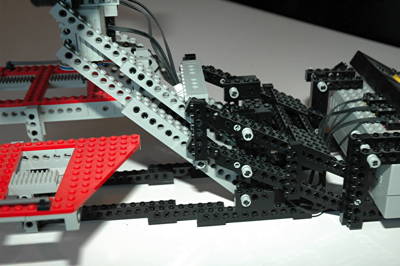
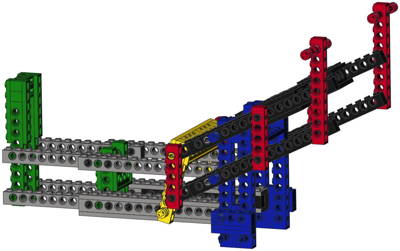
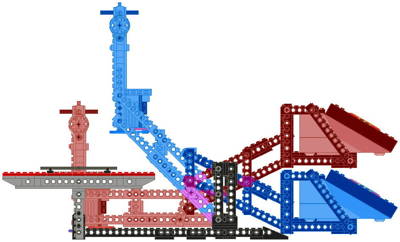
The pitch of the helicopter is motorized and controllable via the side to side motion of the control pad. The motor which drives this motion is housed in the vertical portion of the stand which raises and lowers with the entire model.
The helicopter is mounted to the stand with a box structure called a gimbal. It can rotate on two axes independently or together: pitch and roll. A worm gearbox in the stand allows the pitch rotation nose up and down about 40 degrees.
As can be seen in the computer image, the high speed motor drives through 2 different silicone belts (red and blue). The use of belts rather than gears allows the pulleys to slip rather than stall the motor when the helicopter hits the stops. Each stage of drive belt results in a reduction of about 3:1. A set of bevel gears then drives torque into a third belt (white) which drives a new worm gearbox (hidden). The gearbox both drives and supports a 24 tooth spur gear. The axle at the center of this spur gear (shown in yellow) is coupled to the gimbal (shown in green) with a pair of liftarms such that rotation of the axle directly produces rotation of the gimbal. Because a worm gear is used, the model maintains the attitude at which it was last positioned.
The movement is quite slow thanks to the total gear reduction of (3:1 x 3:1 x 12:12 x 3:1 x 24:1) = 216:1.
The final image shows the nose up and down positions superimposed for comparison.
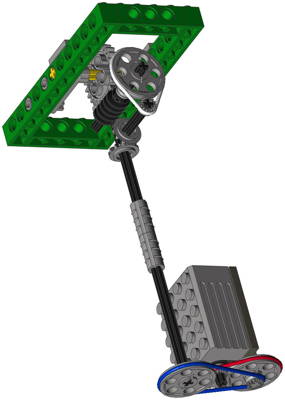
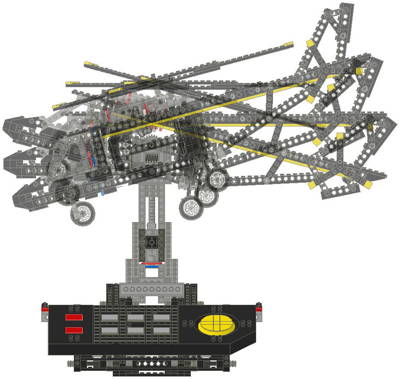
The roll of the helicopter is motorized and controllable via the up and down motion of the control pad. The motor which drives this motion is housed in cockpit of the helicopter model.
The helicopter is mounted to the stand with a box structure called a gimbal. It can rotate on two axes independently or together: pitch and roll. A worm gearbox in the body allows roll port and starboard about 20 degrees. I wouldn't want to roll much further than this in a helicopter.
As can be seen in the computer image, the high speed motor drives through 2 different silicone belts (red and blue). The use of belts rather than gears allows the pulleys to slip rather than stall the motor when the helicopter hits the stops. Each stage of drive belt results in a reduction of about 3:1. A set of bevel gears then drives torque into a set of 8 and 24 tooth spur gears on the right side of the body. Finally, a worm gearbox (hidden) drives and supports the green axle of the gimbal with a pair of rotors such that rotation of the axle directly produces rotation of the gimbal. Because a worm gear is used, the model maintains the attitude at which it was last positioned.
The movement is quite slow thanks to the total gear reduction of (3:1 x 3:1 x 12:12 x 24:8 x 24:1) = 216:1.
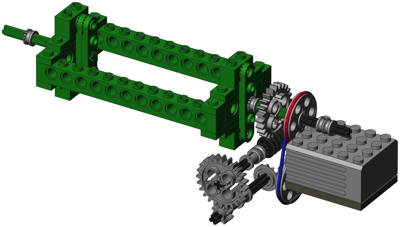
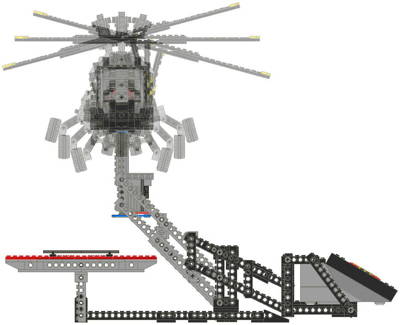
Like virtually all Technic helicopters, the main and tail rotors rotate. In this case, they are motorized to turn at the same rate via a motor located in the body at the approximate position a turbine would be located in a real helicopter. The large A and B buttons on the Control Center command the rotor motion clockwise or counter-clockwise.
As can be seen in the computer image (best seen by zooming in) the high speed motor drives through 2 different silicone belts (both red). The use of belts rather than gears allows the pulleys to slip rather than stall the motor when the rotor is started or stopped. Each stage of drive belt results in a reduction of about 3:1. A set of bevel gears drives both the main and tail rotors.
The 24 tooth gear at the front of the assembly does not actually do anything, it is merely meant to represent the spinning compressor fan of a turbine.
This dinosaur is supported by and integral with a gray stand which contains the Control Center.
The dinosaur can bend down and lower its head almost to the Control Center using a motor mounted in the support stand. As can be seen in the computer image, the high speed motor drives through 2 different silicone belts (red and white). The use of belts rather than gears allows the pulleys to slip rather than stall the motor when the dinosaur bends fully. Each stage of drive belt results in a reduction of about 3:1. A set of 24 and 8 tooth spur gears then drives a worm gearbox. The output axle (shown in green) turns a pair of liftarms which use push rods to rotate the dinosaur at its pivot axle on the stand. Because a worm gear is used, the model maintains the attitude at which it was last positioned.
The movement is quite slow thanks to the total gear reduction of (3:1 x 3:1 x 24:8 x 24:1) = 216:1.
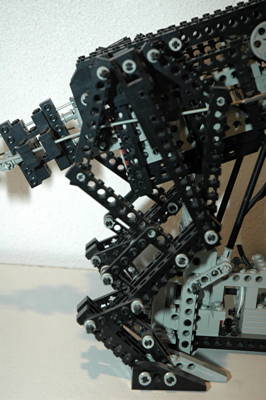
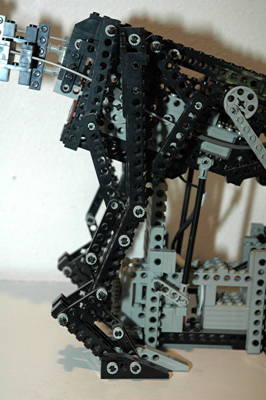
The tail and head wag side to side using a motor in the back of the torso via a system of flexible cables. The head and tail are linked together so that they move in unison. This is a reasonable assumption since a creature with such a massive head would need to use the tail for counter balance.
As can be seen in the computer image, the high speed motor drives through 2 different silicone belts (red). The use of belts rather than gears allows the pulleys to slip rather than stall the motor if the resistance becomes too high. Each stage of drive belt results in a reduction of about 3:1. The second pulley drives a worm gearbox. The output pulleys (shown in yellow) are used as cranks. The left and right side are 180 degrees out of phase and each holds a pair of flex cable ends. Both the head and the tail form a pull-pull loop. Movement of the forward cables tips the head side to side, and movement of the rear cables swings the tail side to side. Because a worm gear is used, the model maintains the attitude at which it was last positioned.
The total gear reduction is (3:1 x 3:1 x 24:1) = 72:1.
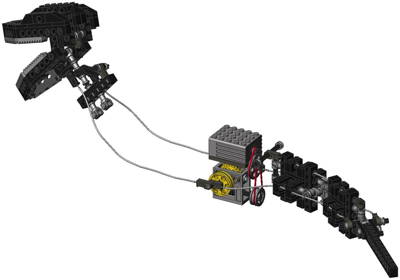
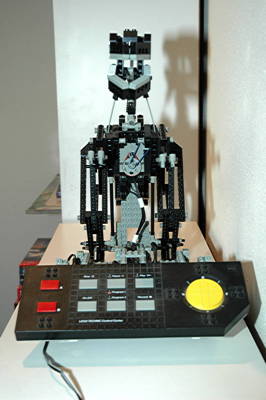
The arms swing up and down and the jaw opens and closes using a motor in the front of the torso. The arms and jaw are linked together so that they move in unison.
As can be seen in the computer image, the high speed motor drives through 2 different silicone belts (red and blue). The use of belts rather than gears allows the pulleys to slip rather than stall the motor if the resistance becomes too high. Each stage of drive belt results in a reduction of about 3:1. The second pulley drives a worm gearbox (hidden). The output pulleys (shown in green) are used as cranks. The left and right side are 180 degrees out of phase. The cranks oscillate the blue arms up and down. Because a worm gear is used, the model maintains the attitude at which it was last positioned.
The total gear reduction is (3:1 x 3:1 x 24:1) = 72:1.
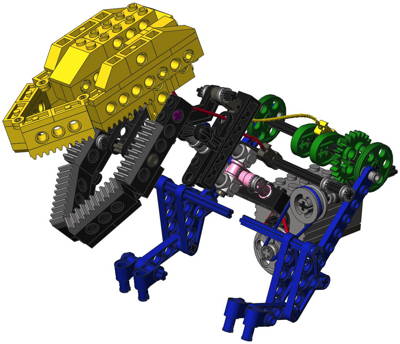

Click to download the LDraw file of this model.
Model by Benjamin Wendl
The model is supported on three hidden tires behind the skirt, two in the front and one in the rear. One of the front wheels is used for actual propulsion while a large fan in the rear is used to simulate the propulsion method of a real air boat.
As can be seen in the computer image, the high speed motor drives through 3 different silicone belts (red). The use of belts rather than gears allows the pulleys to slip rather than stall the motor if the resistance becomes too high. Each stage of drive belt results in a reduction of about 3:1. The first stage is actually two belts in parallel which drive an 8 tooth pinion gear. At this point the gear system splits into two parallel paths.
The lower path drives into a 24 tooth spur and then a pair of 12 tooth bevel gears. The final axle drives the wheel. The total gear reduction is only (3:1 x 24:8 x 12:12) = 9:1. The use of a drive wheel on only one side effectively acts as a differential allowing the front wheels to turn at different speeds.
The upper path also drives a 24 tooth spur which is then followed by another set of pulleys with a red belt. A final reverse gear ratio using spur gears actually speeds the propeller back up. The total gear reduction is (3:1 x 24:8 x 3:1 x 8:24) = 9:1.
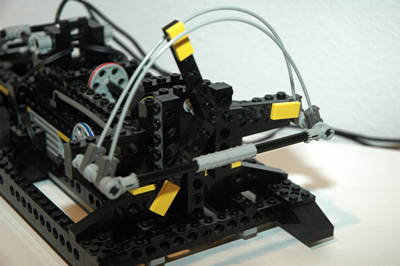
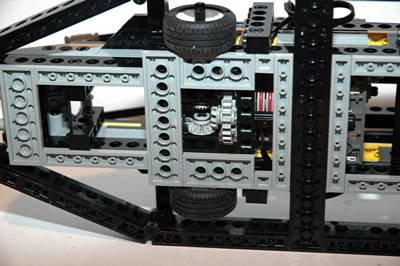
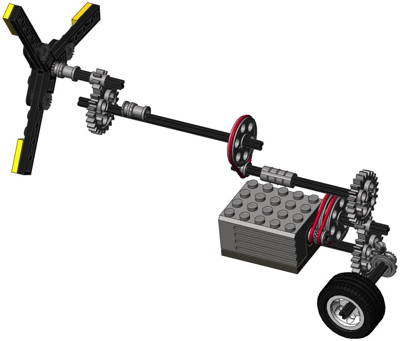
The hidden rear wheel can be steering using a second motor in the body.
As can be seen in the computer image, the high speed motor drives through a silicone belt (blue). The use of belts rather than gears allows the pulleys to slip rather than stall the motor if the resistance becomes too high. Each stage of drive belt results in a reduction of about 3:1. A pinion gear on the motor drives a 24 tooth crown which then drives the belt system. A worm gearbox (hidden) is then used to drive a 24 tooth gear into the steering axle. The total gear reduction is (24:8 x 3:1 x 24:1) = 216:1.
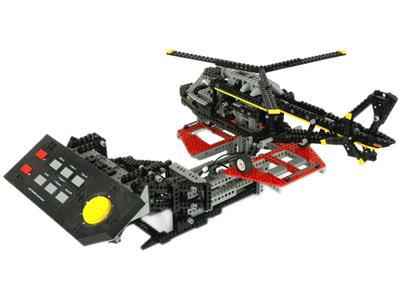
8485 Control Centre II was a 1,079 piece Technic set released in 1995. It was the first LEGO Technic set to use the Control Center. Alternative instructions included were for a helicopter, dinosaur and boat. All of which could use the Control Center for motorization.
The current value for a new and sealed Control Centre II is estimated at 736,00 € with an average yearly gain of about 6%. The current used prices for Control Centre II can be found in the range of 204,00 € and 266,00 € depending on the set's condition, with an average price of 221,00 € if it is in good overall condition.
For Sale (New/Sealed)
Sale Trends
Sets in Technic
8460 Pneumatic Crane Truck
8280 Fire Engine
8440 Formula Flash
8422 Circuit Shock Racer
8412 Nighthawk
8235 Front Loader
8225 Road Rally V
8210 Nitro GTX Bike
My Collection
Set Details
Set Pricing
Quick Buy
Set Facts
- The Control Center was the first programmable power system for LEGO motors. The Control Center has 3 color coded power outputs, each capable of driving a 9V motor.
- The helicopter model can be electrically controlled except for taking off and landing.
- The set is a TECHNIC Tech Build and includes the pieces and building instructions for a helicopter, dinosaur and hovercraft, plus a detailed operations manual.
Control Centre II Reviews
“ The Control Center II from the Lego-Technic series can be described as a special model, because something like this has never existed before (except of course the Control Center 8094 as predecessor). The individual motors are controlled by the electrical control unit. The . More individual movement sequences can be stored as a program, which can then be played back as often as required. This allows complete flight sequences of the helicopter to be simulated. Only the take-off and landing of the helicopter is done manually by raising or lowering the control unit. The model itself is relatively simple, but due to the control unit, the maximum rating of six stars is more than deserved. With this universal set I built and evaluated what I considered the best model.”
“ Though not technically labeled as a Universal Set, the 1995 set 8485 easily holds the title of the best one (with the possible exception of 8479 which is also not technically a Universal Set). It is based around a Control Center programmable electronic battery box nearly . More identical to that first found in 8094 with a very notable exception. Although typically called "Control Center II" by fans due to its obvious succession of 8094, it is actually not labeled as such. Like its predecessor, this is one of my favorite of all Technic sets, and should be the near the top of any collector's acquisition list, but be prepared to pay dearly for it.”
Читайте также:

